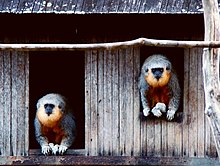Callicebus moloch
| Red-bellied titi | |
|---|---|
 |
|
| Scientific classification | |
| Kingdom: | Animalia |
| Phylum: | Chordata |
| Class: | Mammalia |
| Order: | Primates |
| Suborder: | Haplorhini |
| Family: | Pitheciidae |
| Subfamily: | Callicebinae |
| Genus: | Callicebus |
| Species: | C. moloch |
| Binomial name | |
|
Callicebus moloch (Hoffmannsegg, 1807) |
|
 |
|
| Red-bellied titi range | |
The red-bellied titi or dusky titi (Callicebus moloch) is a species of titi, a type of New World monkey, endemic to Brazil. It lives in forests and thickets.
It has a rounded head and a thick, soft coat and frequently adopts a characteristic posture with the body hunched, limbs close together, and a tail hanging down. The body is 28–39 cm long, and the tail is 33–49 cm.
It can move quite fast if necessary but rarely does so and generally stays within a fairly small area, feeding on fruit, insects, spiders, small birds, and bird's eggs. It is diurnal and moves in pairs or family groups, which communicate by means of a wide repertoire of sounds. The female gives birth to a single offspring.
The red-bellied titi has an average head and body length of 333 mm (13.1 in) for males and 331 mm (13.0 in) for females, showing no sexual dimorphism. Its tail has a greater length than the head and body combined. Males weigh between 850–1,200 g (1.87–2.65 lb) while females range from 700–1,020 g (1.54–2.25 lb).
It has a larger pollex than its hallux. It has six palmar pads and nails on each of its five digits. It has a dental formula of i 2/2, p 3/3, m 3/3 with a total of 36. Its upper incisors are elongated and the incisiform canines barely extend beyond the other teeth. The upper molars are sometimes tricuspid and the lower premolars are relatively simple. Upper and lower molars are quadricuspid. It has relatively large ears often obscured by the fur on side of the head. The nose has a wide internal septum and the nares open laterally. In adults, the pelage of the back can be grey, reddish, or brown. It usually has white or black bands on its forehead. This color pattern found both in young and adults.
The ear has a helical margin that is pulled upward and towards the back. The anterior superior margins are rolled. Tragus and antitragus are small, lobulated and equal in size. The manus has a unique raided pads; the interdigital pads are separated from the palm by a structure called deep flex urge line. The palm consist of two elongated central pads, a hypothenar pad and a thenar pad.
...
Wikipedia

